|
Horse management
 There are many aspects to horse management. Horses, ponies, mules, donkeys and other domesticated equids require attention from humans for optimal health and long life. Living environmentHorses require both shelter from natural elements like wind and precipitation, as well as room to exercise. Worldwide, horses and other equids usually live outside with access to shelter for protection from the elements. In some cases, animals are kept in a barn or stable for ease of access by managers, or for protection from the weather for various reasons. For horse owners who do not own their own land, fields and barns can be rented from a private land owner or space for an individual horse may be rented from a boarding farm. Horses that are not on full-time turnout in a field or pasture normally require some form of regular exercise, whether it is being ridden, longed or turned out for free time. However, if a horse is ill or injured it may need to be confined to a stable, usually in a box stall. As equines are herd animals, most have better mental behavior when in proximity to other equine company. However, this is not always possible, and it has been known for companionship bonds to develop between horses and cats, goats and other species. There are exceptions. Some horses, particularly stallions are often kept separated from other horses, particularly other males they may challenge for dominance. For safety and monitoring, Mares may be separated from a herd prior to foaling. Horses require access to clean fresh water at all times, and access to adequate forage such as grass or hay. Unless an animal can be fully maintained on pasture with a natural open water source, horses must be fed daily. As horses evolved as continuous grazers, it is better to feed small amounts of feed throughout the day than to feed a large amount at one time.  In the winter, horses grow a heavy hair coat to keep warm and usually stay warm if well-fed and allowed access to shelter. But if kept artificially clipped for show, or if under stress from age, sickness or injury, a horse blanket may need to be added to protect the horse from cold weather. In the summer, access to shade is well-advised. PasturesIf a horse is kept in a pasture, the amount of land needed for basic maintenance varies with climate, an animal needs more land for grazing in a dry climate than in a moist one. An average of between one and 3 acres (12,000 m2) of land per horse will provide adequate forage in much of the world, though hay or other feed may have to be supplemented in winter or during periods of drought. To lower the risk of laminitis, horses also may need to be removed from lush, rapidly changing grass for short periods in the spring and fall (autumn), when the grass is particularly high in non-structural carbohydrates such as fructans. Horses turned out to pasture full-time still need to be checked frequently for evidence of injury, parasites, sickness or weight loss. If the terrain does not provide natural shelter in the form of heavy trees or other windbreaks, an artificial shelter must be provided; a horse's insulating hair coat works less efficiently when wet or when subjected to wind, horses that cannot get away from wind and precipitation put unnecessary energy into maintaining core body warmth and may become susceptible to illness.[1] Horses cannot live for more than a few days without water. Therefore, even in a natural, semi-feral setting, a check every day is recommended; a stream or irrigation source can dry up, ponds may become stagnant or develop toxic blue-green algae, a fence can break and allow escape, poisonous plants can take root and grow; windstorms, precipitation, or even human vandalism can create unsafe conditions. Pastures should be rotated when plants are grazed down to avoid overgrazing or deterioration of pasture quality. Manure management is also improved by pasture rotation; horses will not eat grass that contains too much of their own manure and such areas are a breeding ground for parasites. Decomposition of the manure needs to be allowed while the horses are kept in an alternative paddock. Fences and pens Horses evolved to live on prairie grasslands and to cover long distances unfettered by artificial barriers. Therefore, when fenced in, accident potential must be considered. Horses will put their heads and legs through fences in an attempt to reach forage on the other side. They may run into fences if chased by another animal, or even when running at play if the fence (such as a wire fence) is not particularly visible. The smaller the area, the more visible and substantial a fence needs to be.[1] For exercise alone, a pen, run, corral or "dry lot" without forage can be much smaller than a pasture, and this is a common way that many horses are managed; kept in a barn with a turnout run, or in a dry lot with a shelter, feeding hay, allowing either no pasture access, or grazing for only a few hours per day. Outdoor turnout pens range greatly in size, but 12 feet (4 m) by 20 to 30 feet (9 m) is a bare minimum for a horse that does not get ridden daily. To gallop for short stretches, a horse needs a "run" of at least 50 to 100 feet (30 m). When kept in a dry lot, a barn or shelter is a must. If kept in a small pen, a horse needs to be worked regularly or turned out in a larger area for free exercise.[1] 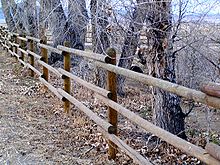 Fences in pens must be sturdy. In close quarters, a horse may contact the fence frequently. Wire is very dangerous in any small pen. Pens are often made of metal pipe, or wood. Larger pens are sometimes enclosed in closely woven mesh, sometimes called "no climb" fencing. However, if a wire mesh is used in a small pen, the openings must be too small for a horse hoof to pass through.[1] Types of fencing Over vast areas, barbed wire is often seen in some parts of the world, but it is the most dangerous fencing material that can be used around horses, even in a large pasture. If a horse is caught in barbed wire, it can quickly become severely hurt, often leaving lasting scars or even permanent injuries. Horse management books and periodicals are nearly universal in stating that barbed wire should never be used to contain horses.[2] However, this advice is widely ignored, particularly in the western United States. Various types of smooth wire fencing, particularly when supported by a strand of electric fence, can be used to enclose a large pasture of several acres, and is one of the least expensive fencing options. A wire fence should have at least four, preferably five strands to provide adequate security. However, even without sharp barbs, wire has the highest potential for horses to become tangled in the fence and injured. If used, it must be properly installed and kept tight through regular maintenance. Visibility is also an issue; a horse galloping in an unfamiliar pasture may not see a wire fence until it is too late to stop.[3] 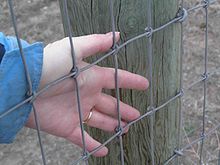 Woven mesh wire is safer but more expensive than strands of smooth wire. It is more difficult to install, and has some visibility issues, but horses are less likely to become tangled in it or be injured if they run into it. Adding a top rail of wood or synthetic material increases visibility of the fence and prevents it from being bent by horses reaching over it. A strand of electric fence may also keep horses from pushing on a mesh fence. Mesh fencing needs to be heavy-gauge wire, woven, not welded, and the squares of the mesh should be too small for a horse to put a foot through. "Field fence" or "no-climb" fence are safer designs than more widely woven "sheep fence." Chain link fence is occasionally seen, but horses can bend chain link almost as easily as a thinner-gauge wire, so the additional expense is often not justified by any gain over good-quality woven wire.[2]  Electric fence comes in many styles of wire, rope and webbing, and is particularly useful for internal division of pastures. It carries only a mild charge that causes a noticeable shock, but no permanent injury to animals or people. It is relatively inexpensive and is easy to install, but if electricity fails, it is easily broken. It is excellent both as a temporary fence and, in single strands, as a top or middle barrier to keep horses away from conventional fencing. There is some danger that horses can become tangled in an electric fence, though because the materials are finer, it usually breaks, stopping the current, though injuries are still possible. Because electricity can fail, it should not be the sole fencing used on property boundaries, particularly next to roads, though a strand on top may be used to keep a horse from leaning over a fence made of other materials. Nor should it be used alone in small pens where horses may accidentally bump into it on a regular basis. However, small single-horse enclosures are sometimes seen at endurance riding competition, where temporary fencing must be set up in remote areas. In residential areas, warning signs should be posted on any boundary fences with electrified sections to keep people from touching the fence and accidentally being shocked.[2] Wood is the "classic" form of horse fencing, either painted planks or natural round rails. It is one of the safest materials for containing horses. Wood or a synthetic material with similar properties is the best option for small paddocks, pens and corrals. It can be used to fence pastures and has some ability to give or break if a horse collides with it. However, wood is expensive, high maintenance and not completely without safety concerns; boards can splinter, nails can stick out and cause lacerations. Wood-like synthetics are even more expensive, but are often safer and lower maintenance.[2] 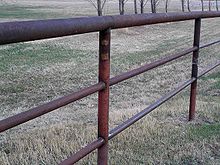 Cable of various sorts is sometimes used for horse fencing, and, especially if combined with a top rail or pipe or wood, can be reasonably safe. However, if cable is not kept tight, like wire, horses can be tangled in it. However, it not only cannot break but unlike wire, it also cannot easily be cut by humans. Its advantage over wire is that it poses less of a risk of entanglement. It is often less expensive than wood or pipe, has some give if a horse runs into it, and requires relatively little maintenance.[4] Metal pipe is often used for fences instead of wood and if properly installed, can be fairly safe in the right circumstances. Pipe is often the most expensive fencing option, but is low maintenance and is very strong. Pipe will generally not give or break if it is run into or if the horse puts a foot through it, which can itself be a potential injury risk; horse owners debate the relative merits and dangers of pipe versus wood for horse fencing. Usually pipe is most suitable for very small areas such as pens where a horse may often bump or test the fence, but will not be at risk of colliding with the fence at full speed.[4]  Barns and stables Horses are sometimes kept indoors.  A horse can be kept in a box stall. Mares with foals often are kept in double stalls.[5]  Feeding 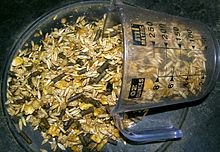 A horse or pony needs approximately 1.5% to 2.5% of its body weight in food per day, depending on its age and level of work.[citation needed] Grooming Horses groomed regularly have healthier and more attractive coats. Many horse management handbooks recommend grooming a horse daily, though for the average modern horse owner, this is not always possible. However, a horse should always be groomed before being ridden to avoid chafing and rubbing of dirt and other material, which can cause sores on the animal and also grind dirt into horse tack. Grooming also allows the horse handler to check for injuries and is a good way to gain the trust of the animal.[6] Hoof care and shoeing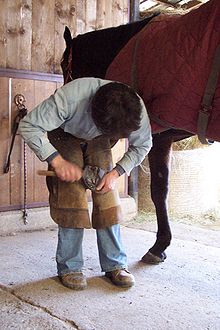  The hooves of a horse or pony are cleaned by being picked out with a hoof pick to remove any stones, mud and dirt and to check that the shoes (if worn) are in good condition. Keeping feet clean and dry wherever possible helps prevent both lameness as well as hoof diseases such as thrush (a hoof fungus). The feet should be cleaned every time the horse is ridden, and if the horse is not ridden, it is still best practice to check and clean feet frequently. Daily cleaning is recommended in many management books, though if horses are on turnout and not being ridden, a weekly hoof check of healthy horses is often sufficient during good weather. Use of hoof oils, dressings, or other topical treatments varies by region, climate, and the needs of the individual horse. Many horses have healthy feet their entire lives without need for any type of hoof dressing. Farriers and veterinarians in a horse owner's local area can provide advice on the use and misuse of topical hoof dressings, offering suggestions tailored for the needs of the individual horse. Horses and ponies require routine hoof care by a professional farrier on average every six to eight weeks, depending on the animal, the work it performs and, in some areas, climate conditions. Hooves usually grow faster in the spring and fall than in summer or winter. They also appear to grow faster in warm, moist weather than in cold or dry weather. In damp climates, the hooves tend to spread out more and wear down less than in dry climates, though more lush, growing forage may also be a factor. Thus, a horse kept in a climate such as that of Ireland may need to have its feet trimmed more frequently than a horse kept in a drier climate such as Arizona, in the southwestern United States. All domesticated horses need regular hoof trims, regardless of use. Horses in the wild do not need hoof trims because they travel as much as 50 miles (80 km) a day in dry or semi-arid grassland in search of forage, a process that wears their feet naturally. Domestic horses in light use are not subjected to such severe living conditions and hence their feet grow faster than they can be worn down. Without regular trimming, their feet can get too long, eventually splitting, chipping and cracking, which can lead to lameness. Horses subjected to hard work may need horseshoes for additional protection. Some advocates of the barefoot horse movement maintain that proper management may reduce or eliminate the need for shoes, or propose hoof boots as an alternative. Certain activities, such as horse racing and police horse work, create unnatural levels of stress and will wear down hooves faster than they would in nature. Thus, some types of working horses almost always require some form of hoof protection. The cost of farrier work varies widely, depending on the part of the world, the type of horse to be trimmed or shod, and any special issues with the horse's foot that may require more complex care. The cost of a trim is roughly half to one-third that of the cost of a set of shoes, and professional farriers are typically paid at a level commeasurate with other skilled labourers in an area, such as plumbers or electricians, though farriers charge by the horse rather than by the hour. In the United Kingdom, it is illegal for anyone other than a registered farrier to shoe a hoof or prepare the hoof to receive a shoe. It is not illegal in the UK for anyone to trim hooves for maintenance or cosmetic purposes, as long as it is not done preparatory to the application of a shoe. The farrier should have any one of the following qualifications, the FWCF being the most highly skilled:
In the United States, there are no legal restrictions on who may do farrier work. However, there are professional organizations, such as the American Farrier's Association (AFA), that maintain a voluntary certification program. Levels of certification in the AFA include:
For each level of certification, farriers must pass written exams (addressing anatomy, physiology, and biomechanics), forging exams (modifications to keg shoes and building shoes from barstock), and live shoeing exams. Once a farrier has completed the highest level of certification (the CJF), he or she can also pursue Specialty Endorsements, such as the TE (Therapeutic Endorsement). Leg care and bandaging The legs of a horse require routine observation for lacerations or swelling. Everyday care involves brushing the legs with a brush to remove dirt and mud. A currycomb is generally not used below the knees. It is common to have excess hair trimmed from the fetlock to prevent excess accumulation of mud and moisture that may lead to skin problems, such as rain rot or scratches. Many riders wrap the horse's legs with protective boots or bandages to prevent injury while working or exercising. After a ride, it is common for a rider or groom to hose off the legs of a horse to remove dirt and to ease any minor inflammation to the tendons and ligaments. Liniment may also be applied as a preventative measure to minimize stiffness and ease any minor strain or swelling. If the horse has been overworked, injured, or is to be transported, a standing bandage or shipping boot may be placed on the horse's legs for protection, to hold a wound dressing, or to provide support. Leg wraps are useful in preventing injury or for treating horses with leg injuries. Veterinarians may recommend using wraps during rehabilitation to prevent further injury. Another common use for leg wraps is to protect the legs of horses while being shipped in a horse trailer.[7] Wrapping legs requires care and skill. A too loose bandage will fall off, potentially tangling in the horse's legs, causing panic or injury. A too tight bandage may cause injury to tendons, ligaments and possible circulation problems. Commercial boots for riding or shipping are simpler to apply as they attach with a hook and loop fastening, or, less often, with adjustable buckles. Leg bandages require more attention. A bandage is usually applied over a protective padding of roll cotton or a premade quilted pad. The bandage is started on the outside of the leg, in the middle of the cannon bone, then wrapped down to either the fetlock or the hoof, depending on the purpose for which it is used, then back up to just under the knee, then back to the center of the cannon just above the starting point, ending on the outside of the leg. When wrapping a horses leg the left leg is wrapped in a counter-clockwise direction, and the right leg is wrapped in a clockwise direction, starting on the outside, moving front to back. Legs may be bandaged with either disposable stretchable wrap that sticks to itself, or with washable fleece or cotton wraps that are reusable and fasten at the ends with a hook and loop closure. Bandages may also be taped with medical tape to help them stay on.[8][9] Veterinary care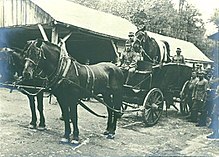 There are many disorders that affect horses, including colic, laminitis, and internal parasites. Horses also can develop various infectious diseases that can be prevented by routine vaccination. It is sensible to register a horse or pony with a local equine veterinarian, in case of emergency. The veterinary practice will keep a record of the owner's details and where the horse or pony is kept, and any medical details. It is considered[by whom?] best practice for a horse to have an annual checkup, usually in the spring. Some practitioners recommend biannual checkups, in the spring and fall.[citation needed] Vaccinations and travel requirementsHorses and ponies need annual vaccinations to protect against any number of sicknesses, though the precise vaccines required varies depending on the part of the world where the horse lives and the uses to which the animal is put. In most nations, rabies and tetanus shots are commonly given, and in many places, various forms of equine encephalitis are a concern as well as West Nile virus. Horses that travel or are exposed to other horses that travel are often recommended to receive equine influenza vaccines, since the disease is highly communicable. In the United States, many people also vaccinate against Equine Herpes Virus strains 1 and 4. Many additional vaccines may be needed, depending on local conditions and risk, including Rhodococcus equi (strangles), Botulism, or Potomac Horse Fever.[10] As a general rule, a horse or pony that has never had a particular vaccination will be given an initial vaccination and then a booster a few weeks later, then normally once a year after that. Animals kept in a public boarding facility, those shipped for breeding and those frequently on the show circuit often require more vaccinations than horses that are not exposed to outside animals and who do not travel. Some type of veterinary certificate or proof of vaccination is often required for horses to travel or compete, especially when crossing state, provincial, or international boundaries. In the US, a certificate stating that the horse has a negative "Coggins" test must be in the vehicle carrying the horse when crossing state lines, and is often required for boarding or showing purposes. This certificate, authorized by a veterinarian, certifies that the horse has been tested recently and does not have an incurable disease called equine infectious anemia (EIA).[11] First-aid kitA well-stocked equine (and human) first-aid kit should be kept in a place where it is easily accessed. Any used or out-of-date items should be replaced as soon as possible. However, other than for minor injuries, a veterinarian should be consulted before treating a sick or injured animal. The basic items any equine first-aid kit should include are:[12]
Parasite controlAll equines have a parasite burden, and therefore treatment is periodically needed throughout life. Some steps to reduce parasite infection include regularly removing droppings from the animal's stall, shed or field; breaking up droppings in fields by harrowing or disking; minimizing crowding in fields; periodically leaving a field empty for several weeks; or placing animals other than equines on the field for a period of time, particularly ruminants, which do not host the same species of parasites as equines. If botflies are active, frequent application of fly spray may repel insects. A small pumice stone or specialized bot egg knife can also scrape off any bot eggs that were laid on the hairs of the horse. Ivermectin is one of the most effective antiparasitics used for horses. It can be used for a wide range of targets including species of the Strongylus nematode.[13] It also is effective against bots. However, having been used heavily for decades, there are concerns that some nematodes are developing resistance.[14] DewormingThere are two common methods of deworming. Purge dewormers that kill parasites with a single strong dose, are given periodically, depending on local conditions and veterinary recommendations. Continuous dewormers, also known as "daily" dewormers, are given in the horse's feed each day, in small doses, and kill worms as they infect the horse. Neither of these methods is perfect; purge dewormers are effective for rapidly killing parasites, but are gone from the horses' body in a few days, and then the horse may start to be re-infected. Continuous dewormers are a mild low dose and may be easier on the horse, but may not be effective in quickly killing worms in a heavily-infected horse and may contribute to drug resistance. If a treatment doesn't kill at least 95% of a worm species, that species is classed as 'resistant' to the drug. For adult horses, frequent rotation of several types of dewormers is no longer recommended, as it can often lead to overtreatment and subsequent drug resistance. Another way of combating drug resistance in adult horses is to deworm less frequently, by performing fecal egg counts on manure and deworming only horses with a high count. This strategy is now recommended by most veterinarians and parasitologists, as it reduces the probability of resistance. For horses that are consistently deemed "low shedders," it is still recommended to deworm at least 1–2 times per year with ivermectin + praziquantel or moxidectin + praziquantel to target tapeworms, bots, and small strongyles. This is typically done in the fall and spring. Dewormers come in several forms, including pastes, gels, powders, and granules or pellets. Powders and granules normally come in single-dose packaging, and the dewormer is normally mixed in with the horse's feed. Pastes and gels normally come in a plastic syringe which is inserted in the side of the horse's mouth and used to administer the dewormer onto the back of the horse's tongue. A dewormer syringe has a plastic ring on the plunger that is turned to adjust the dosage for the horse's weight. Precautions in dewormingDrug resistance is a growing concern for antiparasitic medications. Resistance has been noted with ivermectin to ascarids, and with fenbendazole, oxibendazole, and pyrantel to small strongyles. Development of new drugs takes many years, leading to the concern that worms could out-evolve the drugs currently available to treat them. As a result, most veterinarians now recommend deworming for small strongyles based on fecal egg counts to minimize the development of resistant parasite populations.[15] Fecal egg count reduction tests can also be performed to identify which dewormers are effective on a particular farm. If a horse is heavily infested with parasites, dewormers must be given carefully. Small strongyles can form cysts embedded in the intestinal epithelium. A decrease in the active population of worms, as in the case of deworming, can cause larvae to emerge from the cysts (larval cyathostomiasis). Additionally, foals with a large load of ivermectin-susceptible ascarids in the small intestine may experience intestinal blockage or rupture after deworming. Thus, in heavily-infested animals, a veterinarian may recommend worming with a mild class of drugs, such as fenbendazole or a low-dose daily wormer for the first month or so, followed by periodic purge wormer treatments.[citation needed] Types of parasites found in equines
Ringworm in horses is not actually a worm but a contagious fungal skin disease and is normally treated using an anti-fungal wash. There are several different brands of dewormer, using different types of active chemicals – which in turn kill different types of parasites. It is sometimes necessary to use a specific wormer at a certain time of year, depending on the life cycle of the parasites involved. In the past, horse owners rotated dewormers during the year, using different brands or formulations with different active chemicals, to combat drug-resistant parasites. However, this approach does not appear to prevent drug resistance, and many veterinarians now recommend individualized deworming plans dependent upon the horse's age and egg shedding status. Active chemicals found in different wormers
The medications piperazine and thiabendazole are no longer commonly used as equine wormers; they have been replaced by the above drugs. Dental careA horse's teeth grow continuously throughout its life and can develop uneven wear patterns. Most common are sharp edges on the sides of the molars which may cause problems when eating or being ridden. For this reason a horse or pony needs to have its teeth checked by a veterinarian or qualified equine dentist at least once a year. If there are problems, any points, unevenness or rough areas can be ground down with a rasp until they are smooth. This process is known as "floating". Basic floating can be accomplished by the practitioner pulling the end of horse's tongue out the side of the mouth, having an assistant hold the tongue while the teeth are rasped. The horse will not bite its own tongue, and will often tolerate the floating process if held closely and kept in a confined area where it cannot move. When complex dental work is required or if a horse strenuously objects to the procedure, sedation is used. A horse can also suffer from an equine malocclusion where there is a misalignment between the upper and lower jaws. This can lead to a number of dental problems. Alternative medicineFolk remedies and assorted "natural" treatments are sometimes used with horses. Many have origins in historical remedies used prior to the development of modern veterinary medicine.[17] Others are adapted from alternative practices used by humans. Only a few treatments have been studied enough to establish efficacy, though in some cases the only existing research is on humans or other animals and their effectiveness in horses is unproven.[18] Other remedies have no scientific basis for their use. A few could be harmful. A number of alternative or “natural” remedies, whether useful or not, contain substances banned in competition and will show up in drug testing. One group of common alternative treatments are nutraceutical supplements. The most popular of these are joint supplements such as glucosamine, chondroitin, MSM, and hyaluronic acid. Related to joint supplements are various treatments for pain, viewed as alternatives to the common mainstream pain-reducing medications phenylbutazone, and banamine. Another common group of alternative treatments are “calming” supplements alleged to modify horse behavior. Some of these are basic vitamin or electrolyte concoctions, but others contain banned substances. A significant number of “natural” remedies are prohibited in competition, including but not limited to valerian, kava kava, passionflower, skullcap, chamomile, vervain, leopard’s bane, nightshade, capsaicin, comfrey, devil′s claw, hops, laurel, lavender, red poppy and rawuolfia. Cannabinoids, including CBD, are also banned.[19] Certain substances used by humans are potentially toxic to horses. One example is garlic, sometimes fed to horses as an insect repellent, but it contains N-propyl disulfide, which in horses can affect their red blood cells and can lead to Heinz body anemia.[20] Another substance sometimes fed to horses is yogurt containing active probiotics, usually in the mistaken belief it is a digestive supplement. However, as horses cannot digest lactose, doing so can actually cause diarrhea.[21] Examples of folk remedies that are not effective include feeding chewing tobacco or diatomaceous earth to horses as a dewormer. Neither of these has been proven to work in any empirical study. Others include a practice called gingering alleged to make a horse appear more energetic, but any behavioral changes are generally a result of discomfort caused by the treatment. Sometimes natural remedies are all that is available, particularly in the global south or other isolated remote areas. Examples include horses in certain tropical nations who have sprained tendons or ligaments are treated with rachette (Nopalea cochenillifera), castor bean leaves (Ricinus communis), aloes (Aloe vera) or leaves of wonder of the world (Kalanchoe pinnata). Natural remedies are also used to treat exercise induced pulmonary haemorrhage (EIPH) with lungwort (Pulmonaria officinalis). Other plants used in combination with conventional medications included liquorice (Glycyrrhiza glabra) root, aerial parts of mullein (Verbascum thapsus) or mallow (Althea), and comfrey (Symphytum officinalis) root.[22] Other alternative treatments used on horses include veterinary chiropractic, acupuncture, massage therapy and similar topical, hands-on treatments analogous to those used on humans. Generally there are few studies available on the effectiveness of these as applied to horses.[18] See alsoNotes
References and further reading
External links |